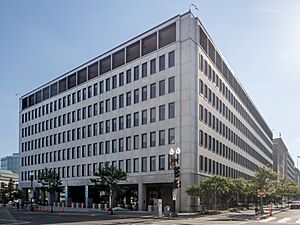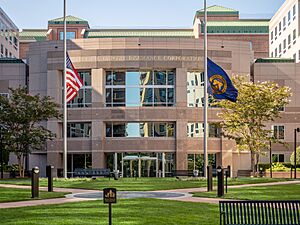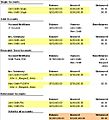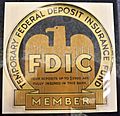Federal Deposit Insurance Corporation facts for kids
| FDIC | |
 |
|
 |
|
 Headquarters on 17th Street NW in Washington, D.C. |
|
| Agency overview | |
|---|---|
| Formed | June 16, 1933 |
| Jurisdiction | Federal government of the United States |
| Employees | 6,352 (2024) |
| Annual budget | $1.96 billion (2024) |
| Agency executive |
|
The Federal Deposit Insurance Corporation (FDIC) is a special part of the United States government. Its main job is to protect the money people put into banks. It does this by providing "deposit insurance" for bank accounts. This means if a bank fails, the FDIC makes sure you get your money back, up to a certain amount.
The FDIC was created in 1933 during a tough time called the Great Depression. Back then, many banks were failing, and people lost trust in the banking system. The FDIC was made to help people feel safe about putting their money in banks again. Since it started, no one has ever lost money that was insured by the FDIC.
The FDIC gets its money from banks, not from taxes. Banks pay fees to the FDIC to be part of this insurance program. As of 2024, the FDIC protects deposits at over 4,500 banks.
Contents
How the FDIC Protects Your Money
The FDIC does more than just insure deposits. It also checks on banks to make sure they are safe and sound. This helps prevent banks from getting into trouble in the first place.
What Happens if a Bank Fails?
If a bank can no longer stay in business, the government closes it. Then, the FDIC steps in to help. Its main goals are to protect the people who have money in the bank and to get back as much money as possible for the bank's other creditors.
The FDIC has two main ways to handle a failed bank:
- Selling the Bank: Often, the FDIC will arrange for a healthy bank to buy the failed bank. This way, customers' accounts are simply moved to the new bank, and they can keep using their money as usual.
- Paying Out Deposits: If no other bank buys the failed one, the FDIC directly pays back the insured money to the customers. This usually happens very quickly, often within a few days.
What Money Is Insured?
The FDIC insures many common types of bank accounts. This includes:
- Checking accounts
- Savings accounts
- Money market accounts (MMDAs)
- Certificates of deposit (CDs)
- Cashier's checks and other official checks from the bank
It's important to know that accounts at different banks are insured separately. So, if you have money in two different FDIC-insured banks, your money at each bank is protected up to the limit. Even if you are not a U.S. citizen, your deposits in a U.S. FDIC-insured bank are covered.
What Is Not Insured?
Some things are not covered by FDIC insurance, even if you buy them at a bank. These include:
- Stocks and bonds
- Mutual funds
- Life insurance or car insurance policies
- The contents of safe deposit boxes (these are just rented storage spaces)
FDIC insurance only protects you if the bank itself fails. It does not cover losses from theft, fraud, or mistakes made by the bank.
How Much Money Is Insured?
Currently, the FDIC insures deposits up to $250,000 per person, per bank, and per "ownership category." This means that different ways you own money can be insured separately.
Here are some common ownership categories:
- Single Accounts: Money you own by yourself.
- Joint Accounts: Money owned by two or more people together. For example, if three people share a $750,000 account, the whole amount is insured because each person's $250,000 share is covered.
- Retirement Accounts: Like Individual Retirement Accounts (IRAs).
- Trust Accounts: Money held in a trust for someone else.
The amount of insurance has increased over the years to keep up with inflation. It started at $2,500 in 1934 and was permanently set at $250,000 in 2010.
How the FDIC Is Funded
The FDIC does not use money from the government's regular budget. Instead, it collects fees, called premiums, from the banks it insures. These premiums go into a special fund called the Deposit Insurance Fund (DIF).
The DIF is used to pay for the FDIC's operations and to pay back depositors when a bank fails. The amount each bank pays depends on how much money it has insured and how risky it is. The DIF also earns interest from investments in U.S. government securities.
Sometimes, during big financial crises, the FDIC has used up its entire insurance fund. When this happens, it can borrow money from the government to make sure everyone gets their insured deposits back. It has always paid back these loans.
History of the FDIC
The idea of protecting bank deposits came about after several financial panics in the late 1800s and early 1900s. People would rush to banks to pull out their money, causing banks to fail.
The Great Depression and FDIC's Start
Before the FDIC was created, thousands of banks failed between 1929 and 1933. This was a huge problem during the Great Depression. People lost their life savings, which made the economic crisis even worse.

Even though some people, including President Franklin D. Roosevelt, were unsure about insuring bank deposits, the public really wanted it. So, on June 16, 1933, President Roosevelt signed a law that created the FDIC. This law made the FDIC a temporary agency at first, but it became a permanent government agency in 1935.
Challenges and Changes
The FDIC faced its first big challenge in the late 1980s and early 1990s during the "savings and loan crisis." Many savings and loan institutions (S&Ls) failed. The FDIC took over the job of insuring these S&Ls and helped resolve the crisis.

The biggest challenge for the FDIC came during the 2008 financial crisis. Many large banks failed, including Washington Mutual. The FDIC worked hard to manage these failures and protect depositors. To help people feel more confident, the insurance limit was temporarily raised to $250,000, and this amount was later made permanent.
The FDIC continues to adapt and improve its ways of protecting bank customers and keeping the financial system stable.
Leaders of the FDIC
The FDIC is led by a Board of Directors. This board has five members. Three members are chosen by the President of the United States and approved by the Senate. The other two members are already in important government jobs: the Comptroller of the Currency and the Director of the Consumer Financial Protection Bureau.
The President also chooses one of the appointed members to be the Chairman of the Board.
Current Board Members
As of July 2025, here are the current board members:
| Position | Name | Party | Assumed office | Term expiration |
|---|---|---|---|---|
| Vice chairman (acting chairman) | Travis Hill | Republican | January 5, 2023 | December 21, 2028 |
| Comptroller of the Currency (ex officio) |
Jonathan Gould | Republican | July 15, 2025 | July 15, 2030 |
| Director, CFPB (ex officio) | Russell Vought (acting) | Republican | February 7, 2025 | — |
| Member | Vacant | N/A | — | December 21, 2028 |
| Member | Vacant | N/A | — | May 31, 2030 |
Images for kids
See also
 In Spanish: Corporación Federal de Seguro de Depósitos para niños
In Spanish: Corporación Federal de Seguro de Depósitos para niños
- 1933 Banking Act
- List of bank failures in the United States (2008–present)
- List of largest bank failures in the United States
Related agencies and programs
- Canada Deposit Insurance Corporation—Canada's version of the FDIC
- National Credit Union Share Insurance Fund—Protects money in credit unions



